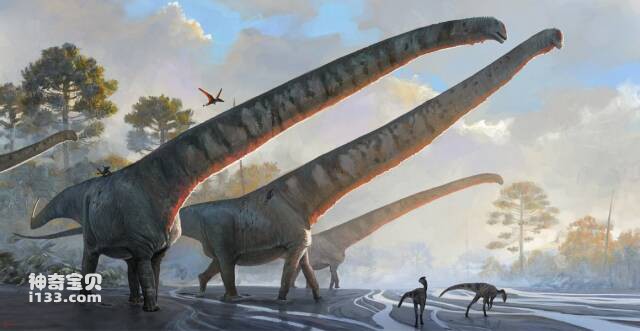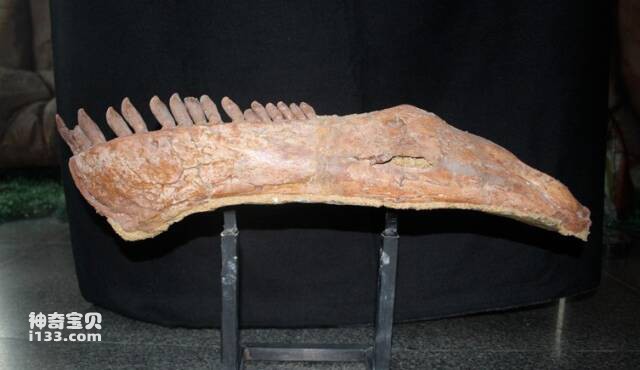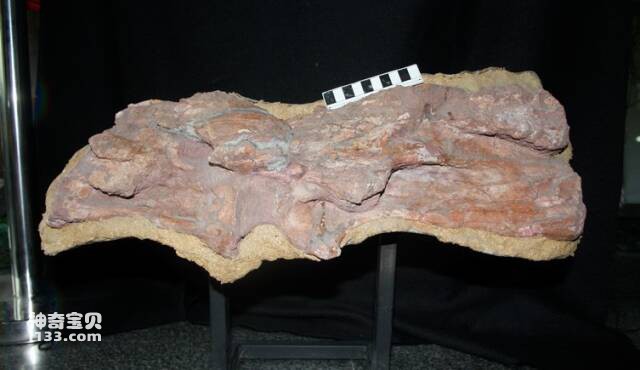A sauropod from China may have had the longest neck of any known dinosaur. The discovery comes 30 years after the species was first discovered, as scientists try to learn more about how sauropods evolved in what is now East Asia.
About 160 million years ago, during the late Jurassic period, a strange dinosaur roamed the Chinese mainland.
Sauropods are known for their long necks, but Mamenchisaurus's neck towered into the sky at 15 meters.
Despite this record-breaking feature, Mamenchisaurus is far from the largest dinosaur ever discovered due to its relatively small tail and body.
Scientists are trying to understand why this dinosaur may have had such a long neck.

The sauropod Mamenchisaurus sinocanadorum has a 15-meter-long neck, which is taller than other dinosaurs.
Professor Paul Barrett, a dinosaur expert at the museum and one of the study's authors, said: "It appears that these necks may have enhanced feeding capabilities as in other sauropods, but it may have had more than one role."
"It could also be related to sexual displays, or used in neck-butting competitions between males competing for mates and territory, similar to what giraffes do today. But we can't say for sure. At this point, it's purely about Speculations on why they evolved such long necks.
The research has been published in the Journal of Systematic Paleontology.
Fossil jaw of Mamenchisaurus sinensis on a stand

Only a few fossil fragments of Mamenchisaurus from South China have been discovered so far, such as this mandible.
Why do you need a long neck?
Sauropods were a group of very large plant-eating dinosaurs known for their exceptionally long necks and tails.
Notable members of this group include Diplodocus, Brachiosaurus and the giant Patagotitan, one of the largest animals that ever lived.
Scientists believe that sauropods evolved long necks as part of their feeding strategy, allowing them to consume large amounts of food in the immediate area around them without expending as much energy moving around .
Questions remain about how Mamenchisaurus sinocanadorum's bizarre proportions enabled it to function on a day-to-day basis.
"We really don't know how that animal works mechanically," Paul said.
"It takes a lot of muscles to support such a large neck, and then the question is how does it get air into the lungs and up again."
"This may support the theory that these necks were a sexually selected trait, with only the strongest and healthiest dinosaurs able to support these huge necks in an impressive way to mate."
Only one specimen of Mamenchisaurus sinensis has been found. It is an incomplete skeleton consisting of the front end of the neck, including an impressive rib and several skull bones, including the mandible.
The lack of a complete skeleton makes it difficult for scientists to understand the dinosaur's overall size, and they need another better-preserved sauropod skeleton for comparison.
In 2012, a new type of giant sauropod dinosaur from China was discovered, named Xinjiang Titan, which had a complete neck. The researchers compared the incomplete fossil of Mamenchisaurus from South China to fossils of sauropods such as Titan from Xinjiang to work out what the length of the neck might have been.
"We achieved this using just a little bit of basic mathematics," Paul explained.
"We just looked at the proportions of individual vertebrae in the complete neck as a guide to enlarging the entire neck of the incomplete Mamenchisaurus sinensis."
"So we measured the vertebrae of one dinosaur and the corresponding bones of another dinosaur and calculated the difference. We then multiplied the length of each vertebra of the complete neck by that factor to estimate the size of Mamenchisaurus sinensis neck length.
Two fossilized vertebrae of Mamenchisaurus sinensis mounted on a bracket

These two vertebrae from the Chinese Canadian species Mamenchisaurus were used to estimate their total neck length.
Ancient Chinese megafauna
In August 1987, the broken end of a huge cervical rib was discovered at a site in the Shishugou Formation in northwest China, and the fossil of Mamenchisaurus sinensis was discovered.
The site is located in Xinjiang and is a rich vertebrate fossil deposit, including dinosaur, pterosaur and crocodile fossils from the Middle Jurassic to the Late Jurassic. To date, four other sauropods have been named from this formation.
Mamenchisaurus is a group of unusually long-necked dinosaurs mainly found in China, first discovered in the 1950s. Since then, scientists have unearthed other similar specimens, prompting a re-evaluation of the group to determine how related its many different species are.
"In the late Jurassic, sauropods were widely distributed in China," Paul said.
We're trying to uncover just how many different types of sauropods were roaming around during this time, and how they were related to other sauropods elsewhere in the world.
"There are suggestions that Mamenchisaurus was only found in China, which was a huge isolated island continent during the Jurassic period. Others suggest that sauropods evolved slightly differently in China than elsewhere in the world.
"We are revisiting these specimens with colleagues in China and using modern methods and new knowledge about sauropods to learn more about these dinosaurs and how they traveled the globe."
animal tags:
We created this article in conjunction with AI technology, then made sure it was fact-checked and edited by a Animals Top editor.